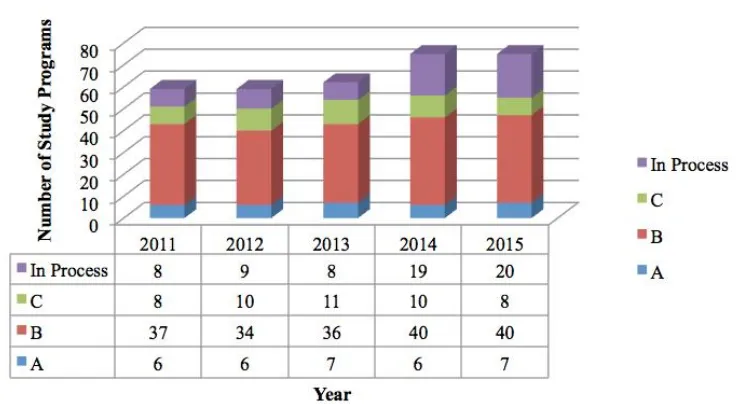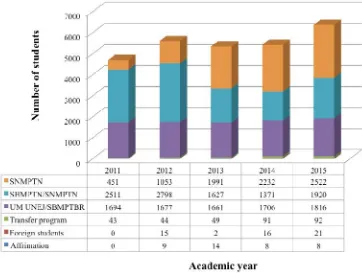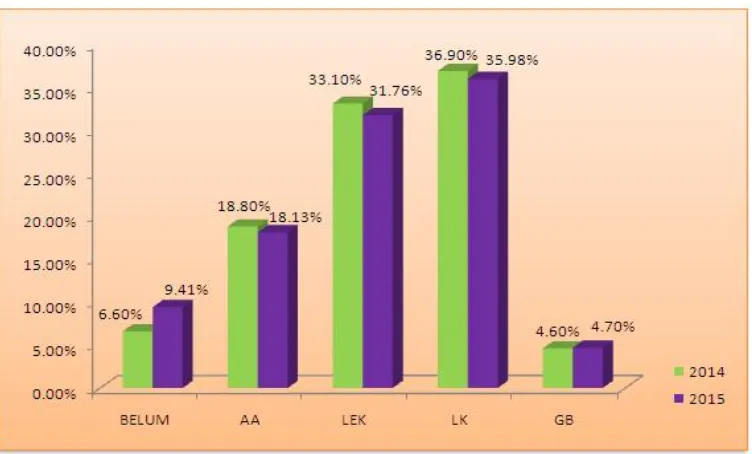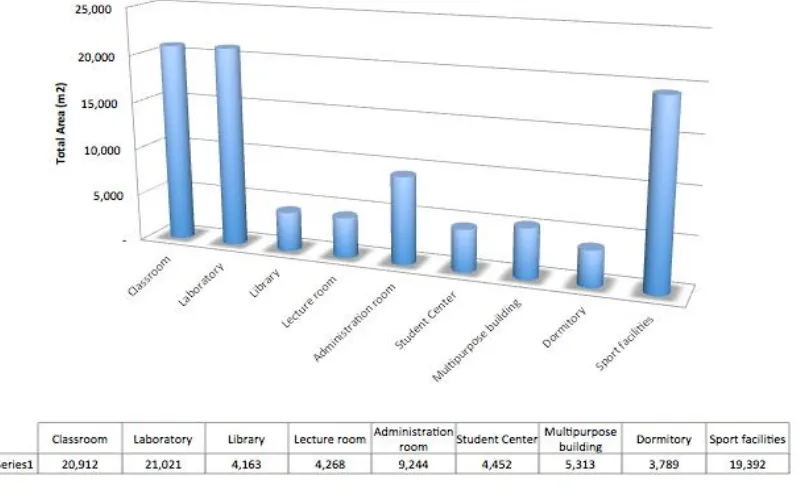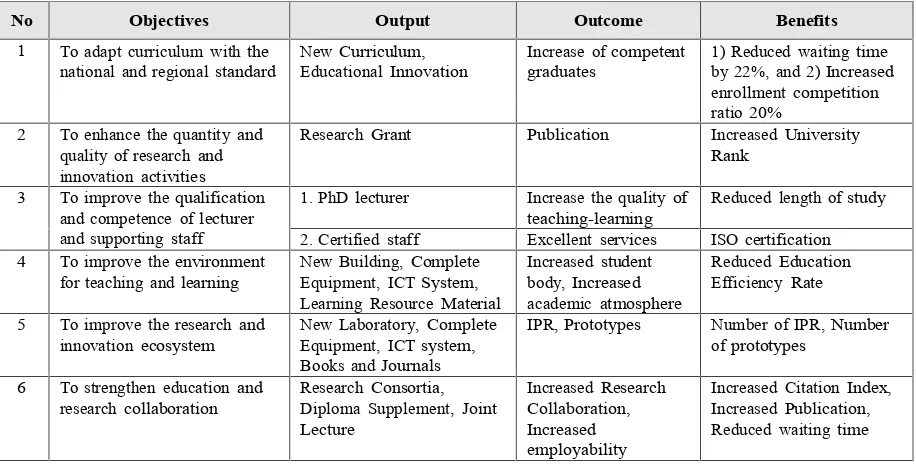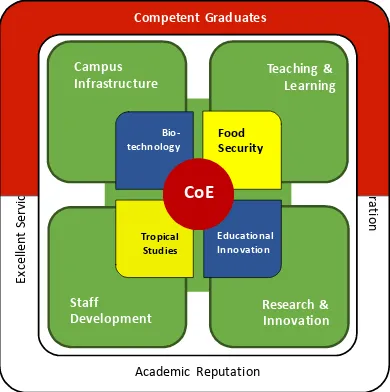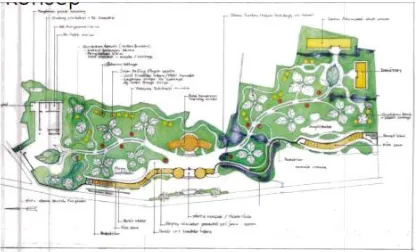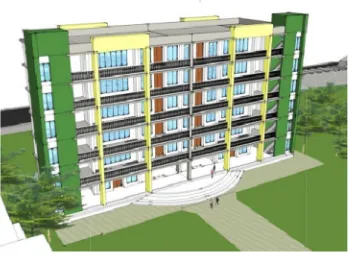PROJECT PROPOSAL
Project Title
The Development of University of Jember
as Center of Excellence for Biotechnology in Agriculture
and Health
Total of Project Cost
US$ 47,249,688
Proposed to IDB
US$ 44,021,900
Proposed to GOI
US$ 3,158,488
Executing Agency
Ministry of Research, Technology and Higher Education
Location
University of Jember
Sector
Education
Sub-Sector
Higher Education
Duration of the Project
2016 – 2019 (48 Months)
Individual Authorized to
Sign for the University of Jember
RECTOR MOH. HASAN
MINISTRY OF RESEARCH, TECHNOLOGY, AND HIGHER EDUCATION
THE UNIVERSITY OF JEMBER
Address: Jalan Kalimantan No. 37 – Kampus Tegal Boto. PO Box 159 Jember
Telp. (0331) 330224, 333147, 334267. Fax.: (0331) 339029, 337422
Website: www.unej.ac.id
PREFACE
All praise and thanks be to God Almighty, finally we can finish the proposal of the
development of University of Jember as Center of Excellence for Biotechnology in
Agriculture and Health to the Government of Republic of Indonesia. This development
effort is in-line with the direction of development in the university and the institution's
strategic plan. University of Jember has launched a strategic plan to become an excellent
university in Southeast Asia region and exist in Asia by 2022.
University of Jember has a long experience in performing and producing quality research
and education. One of the most notable areas is biotechnology-based research. In recent
years, researchers of University of Jember have produced a number of research products in
the field of genetic engineering, bioinformatics and bio-molecular. Based on experience,
strength, research performance, publication and quality of faculty members, University of
Jember in this program will develop Biotechnology in Agriculture and Health as a Center
of Excellence (CoE). Studied within trans- and multidiscipline, biotechnology becomes
the major concern of the institution. Various activities will be implemented, so that
university of Jember becomes a pioneer in internationally recognized and reputable
biotechnology education, research, and services.
We believe that we cannot achieve these goals alone. These require support from various
parties, especially from the Government of the Republic of Indonesia, in particular the
Ministry of Research, Technology and Higher Education, National Development Planning
Agency (BAPPENAS) and donor agencies such as the Islamic Development Bank (IDB).
We hope that our opportunities to develop University of Jember as Center of Excellence in
Biotechnology in Agriculture and Health will be supported.
Jember, January 2016
MOH. HASAN
TABLE OF CONTENT
1. The Project ... 1
1.1 Rationale ... 1
1.1.1 The Existing Condition of University of Jember... 1
1.1.2 The Condition of Curriculum ... 3
1.1.3 The Condition of Human Resources... 9
1.1.4 Conditions of Research and Publications ... 11
1.1.5 The Condition of Equipment and Other Supporting Facilities ... 14
1.1.6 Condition of Building Including Classrooms ... 15
1.1.7 Sector Information in the Project Area ... 16
1.1.8 Vision and Mission of The University of Jember... 17
1.1.9 Strategic Plan of University of Jember ... 18
1.1.10 Project Relevance and Importance ... 19
1.1.11 Existing facilities ... 22
1.2 Objectives and Scopes... 23
1.2.1 Project objectives and benefits ... 23
1.2.2 Project concept... 24
1.2.3 Implementation Strategy ... 25
1.3 Program Development... 26
1.3.1 Curriculum Development ... 26
1.3.2 Research Consortia ... 29
1.4 Project scope... 34
1.4.1 Civilworks... 34
1.4.2 Equipment Procurements... 40
1.4.3 Staff Development ... 41
1.4.4 Program Management Unit (PMU) and
Project Implementation Unit (PIU) ... 45
1.4.5 Start up Workshop, and Midterm Review and Familiarization ... 46
1.5 Implementation Plan ... 46
1.6 Project Location ... 47
1.6.1 Geographical location ... 47
1.6.2 Infrastructural support facilities... 48
1.6.3 Adverse physical conditions ... 49
1.6.4 Technical Evaluation and Engineering Characteristics ... 50
1.6.5 Specifications and architecture ... 52
1.6.6 Construction Materials... 53
1.6.7 Man Power and Sources ... 54
1.7 Building Operation, Maintenance, and Program Sustainability ... 57
1.8 Environmental Aspects... 57
1.8.1 Effects of the project on Environment and Ecology... 57
2. Project Cost Estimation ... 59
2.1 General Cost Components ... 59
2.2 Cost Component Breakdown ... 60
2.2.1 Civilworks cost Breakdown... 60
2.2.2 Equipments Procurement cost Breakdown ... 61
2.2.3 Staff Development Cost Breakdown ... 61
2.2.4 Project Planning and Administration Cost Breakdown ... 63
2.4 Procurement Procedure ... 64
3. Executing Agents ... 65
3.1 Legal Status, Objectives and Functions ... 65
3.2 Organizational and Management ... 65
3.3 Workshop and Technical Assistance... 68
3.4 Budgeting and Accounting ... 68
3.5 Past Performance and Future Outlook ... 68
3.6 Project Monitoring... 69
4. Economic Justification ... 71
4.1 Basic assumption ... 71
4.2 Economic Rate of Return ... 71
4.2.1 Benefits ... 72
4.3 Sensitivity Analysis ... 74
4.4 Social and other benefits that cannot be calculated... 75
4.4.1 Physical Development (Civil work) ... 75
4.4.2 Staff Development ... 77
5. Conclusion and Recommendations ... 78
5.1 Technical Soundness of the Project Proposal... 78
5.2 Importance of the Project to the National Economy ... 78
5.3 Benefits Accruing as a Result of Establishing the Project ... 79
6. Annexes... 80
6.1 Map of country with project location... 80
6.2 Layout of the project ... 81
6.2.1 University block plan at Tegalboto Area... 81
6.2.2 University block plan at Jubung Area ... 81
6.2.3 Design of Building for Integrated Laboratories... 82
6.2.4 Design Training Center... 83
6.2.5 Design Training Center Dormitory... 83
6.2.6 Design Auditorium University of Jember... 84
6.3 Cash Flow ... 84
6.3.1 Revenue in IDR ... 84
6.3.2 Expenditures in IDR ... 85
6.3.3 Net Benefit, Investment, and Net Cash Flow ... 86
6.4 EIRR (Economic Internal Rate of Return (FIRR) ... 87
6.5 FIRR (Financial Internal Rate of Return (FIRR) ... 88
6.6 Organization chart of the executing agency ... 89
6.7 Project Implementation Bar Chart ... 89
LIST OF TABLE
Table 1. The evaluation of the performance of UNEJs' lecturers ... 5
Table 2. Titles of scientific articles/works/art works/book produced within the last three
years by permanent lecturers... 13
Table 3. Sector Information in The Project Area ... 16
Table 4. Target of the achievement of the University of Jember of Strategic Objectives of
Performance ... 21
Table 5.
Existing Ratio of Facilities in University of Jember... 22
Table 6.
Objectives, output, outcome, and benefit of the project to University of Jember .. 23
Table 7.
List of candidates for degree training (Doctoral Degree) ... 42
Table 8.
List of candidates for non-degree training (Mid-term research collaboration)... 43
Table 9.
Schedule of Project Implementation ... 47
Table 10. Structure and Architecture specification... 53
Table 11. Skilled labor for civil works construction management requirement ... 54
Table 12. Skilled labor for civil works supervising management requirement ... 55
Table 13. Skilled labor for construction of civil works requirement ... 55
Table 14. Non-skilled labor for civil works requirement... 56
Table 15. The cost components for University of Jember ... 59
Table 16. Cost component breakdown for civilworks ... 60
Table 17. Cost component breakdown for Equipments Procurement ... 61
Table 18. Cost component breakdown for Equipments Procurement ... 62
Table 19. Cost component breakdown for Project Planning and Administration ... 63
Table 21. Benefits ... 72
Table 22. NPV Financial Rate of Return (FIRR)... 72
Table 23. FIRR... 73
Table 24. NPV EIRR (Eonomic Internal Rate of Return) ... 73
Table 25. EIRR ... 74
Table 26. Changing of FIRR and EIRR at diffent exchange rate ... 74
LIST OF FIGURE
Figure 1.
Number of Study Programs ... 1
Figure 2.
Number of Study Programs based on Accreditation ... 2
Figure 3.
New Students' Interest in 2011-2015... 4
Figure 4.
Development of Number of New Students in 2011-2015 ... 4
Figure 5.
Trend in Student Length of Study in 2011-2015 ... 5
Figure 6.
Trend in student length of study without thesis in 2011-2015 ... 6
Figure 7.
Trend in Length of study less than 4 years in 2011-2015 ... 7
Figure 8.
Trend in length of final project Completion in 2011-2015 ... 7
Figure 9.
The development of GPA in 2011-2015... 8
Figure 10. The waiting period of Job during 2011-2015 ... 8
Figure 11.
Distribution of the Qualifications of Lectures ... 9
Figure 12. Increase in Lecturer Functional Positions in 2015 ... 10
Figure 13. Ratio of Lectures and Students 2015 ... 11
Figure 14. Progress of the Number of Research Titles in 2011-2015... 13
Figure 15. RGA developments in 2011-2015 ... 13
Figure 16. Building Area of University of Jember ... 15
Figure 17. Conceptual Framework 4 in 1 consortium ... 24
Figure 18. The strategy and programs on strengthening of Center of Excellence
Biotechnology... 25
Figure 19. Civilworks location in Tegalboto area (upper) and in Jubung Area (bottom)... 35
Figure 20. Prototype of Integrated Laboratory ... 37
Figure 21. Prototype of Auditorium of University of Jember... 37
Figure 22. Prototype of Training Center on Agrotechnopark of University of Jember ... 38
Figure 23. Prototype of Limited Land Testing and its greenhouses ... 39
Figure 24. Prototype and design of Agribussiness incubator area in Jubung ... 39
Figure 25. Prototype of Training Center Dormitory ... 40
Figure 26. Location of Jember Regency (red dot) in Java Island ... 48
Figure 27. Location of University of Jember ... 48
1.
The Project
1.1
Rationale
1.1.1 The Existing Condition of University of Jember
The challenges in educating young population of the nation are increasing due to the
rising number of students and the demand for graduates’ quality that is parallel to the
advancement of technology. Meanwhile, the condition of higher education institution in
Indonesia in general is still poor. The way to measure the quality of a university is
accreditation. Accreditation also plays an important role in demonstrating the quality of
learning at University of Jember. Accreditation is a reflection of quality achievement of
highly competitive graduates.
University of Jember (UNEJ) has grown rapidly and recently has 13 faculties and 2 study
programs equivalent with faculty: (1) Faculty of Law, (2) Faculty of Social and Political
Sciences, (3) Faculty of Agriculture, (4) Faculty of Economics, (5) Faculty of Letters, (6)
Faculty of Teacher Training and Education, (7) Faculty of Agricultural Technology, (8)
Faculty of Dentistry, (9) Faculty of Mathematics and Natural Science, (10) Faculty of
Medicine, (11) Faculty of Public Health, (12) Faculty of Engineering, (13) Faculty of
Pharmacy, (14) Nursing Science Study Program, and (15) Information System Study
Program. The Study Programs (PS) managed by UNEJ until 2015 have been as many as 75
programs: 5 programs for doctoral, 15 programs for Master, 41 programs for undergraduate,
and 9 programs for diploma (vocation). In addition, UNEJ has organized 5 professional
education programs, namely Doctor Professional Education, Dentist Professional Education,
Nurse (Nursing) Professional Education, Teacher Professional Education and Pharmacist
Professional Education.
Figure 1. Number of Study Programs
1.
The Project
1.1
Rationale
1.1.1 The Existing Condition of University of Jember
The challenges in educating young population of the nation are increasing due to the
rising number of students and the demand for graduates’ quality that is parallel to the
advancement of technology. Meanwhile, the condition of higher education institution in
Indonesia in general is still poor. The way to measure the quality of a university is
accreditation. Accreditation also plays an important role in demonstrating the quality of
learning at University of Jember. Accreditation is a reflection of quality achievement of
highly competitive graduates.
University of Jember (UNEJ) has grown rapidly and recently has 13 faculties and 2 study
programs equivalent with faculty: (1) Faculty of Law, (2) Faculty of Social and Political
Sciences, (3) Faculty of Agriculture, (4) Faculty of Economics, (5) Faculty of Letters, (6)
Faculty of Teacher Training and Education, (7) Faculty of Agricultural Technology, (8)
Faculty of Dentistry, (9) Faculty of Mathematics and Natural Science, (10) Faculty of
Medicine, (11) Faculty of Public Health, (12) Faculty of Engineering, (13) Faculty of
Pharmacy, (14) Nursing Science Study Program, and (15) Information System Study
Program. The Study Programs (PS) managed by UNEJ until 2015 have been as many as 75
programs: 5 programs for doctoral, 15 programs for Master, 41 programs for undergraduate,
and 9 programs for diploma (vocation). In addition, UNEJ has organized 5 professional
education programs, namely Doctor Professional Education, Dentist Professional Education,
Nurse (Nursing) Professional Education, Teacher Professional Education and Pharmacist
Professional Education.
Figure 1. Number of Study Programs
1.
The Project
1.1
Rationale
1.1.1 The Existing Condition of University of Jember
The challenges in educating young population of the nation are increasing due to the
rising number of students and the demand for graduates’ quality that is parallel to the
advancement of technology. Meanwhile, the condition of higher education institution in
Indonesia in general is still poor. The way to measure the quality of a university is
accreditation. Accreditation also plays an important role in demonstrating the quality of
learning at University of Jember. Accreditation is a reflection of quality achievement of
highly competitive graduates.
University of Jember (UNEJ) has grown rapidly and recently has 13 faculties and 2 study
programs equivalent with faculty: (1) Faculty of Law, (2) Faculty of Social and Political
Sciences, (3) Faculty of Agriculture, (4) Faculty of Economics, (5) Faculty of Letters, (6)
Faculty of Teacher Training and Education, (7) Faculty of Agricultural Technology, (8)
Faculty of Dentistry, (9) Faculty of Mathematics and Natural Science, (10) Faculty of
Medicine, (11) Faculty of Public Health, (12) Faculty of Engineering, (13) Faculty of
Pharmacy, (14) Nursing Science Study Program, and (15) Information System Study
Program. The Study Programs (PS) managed by UNEJ until 2015 have been as many as 75
programs: 5 programs for doctoral, 15 programs for Master, 41 programs for undergraduate,
and 9 programs for diploma (vocation). In addition, UNEJ has organized 5 professional
education programs, namely Doctor Professional Education, Dentist Professional Education,
Nurse (Nursing) Professional Education, Teacher Professional Education and Pharmacist
Professional Education.
details can be seen on the following figure.
The process of improving the quality of education at the University of Jember is
conducted continuously from the input, process and output of learning integrated with human
resource development through academic activities of national and international level at the
University of Jember. Institutional management is also the entire aspect of campus academic
activities. An evidence that indicates various aspects of institutional management made by
UNEJ is the achievement of UNEJ institutional accreditation status with predicate A by BAN
PT 2015, which also reflects that the 10 standards of higher education as outlined by Law No.
12 of 2012 have been implemented in UNEJ and have been recognized by external parties
very well. However, these achievements have not been followed by most of the study
programs to achieve the predicate A. Only about 10% of total study programs accredited A.
More
Figure 2. Number of Study Programs based on Accreditation
through quality documents in the form of: quality policy; quality manual, work procedures,
work instructions that are accompanied with forms for documenting of data on quality
activities.
BPM also implements total mentoring on the activities of study program accreditation,
supported by SOP on accreditation process, ensuring the implementation of accreditation to
certify the quality of proposal. Based on BPM analysis of 2015, the weaknesses of study
programs in the accreditation are reflected by lack of cooperation and poor national and
international research. Therefore, two things should be improved in an integrated manner by
the entire academic community members of the University of Jember. Beside, BPM also
provides guidance in the proposal of new courses and also reviews the planning within the
work unit at the University of Jember as well as monitors ISO certification of the work units
at the University of Jember. By 2015, 3 work units at UNEJ have already owned ISO
certificate.
1.1.2 The Condition of Curriculum
In general, the curriculum of University of Jember is arranged according to the
assumption and imitation from previous models. Although a degree of autonomy in preparing
curriculum has begun to pass to higher education institutions, the curriculum has not been
entirely designed through analysis of labor market demands and problems developing in the
society. The quality of university’s curriculum can be seen from several aspects such as the
input process, the quality of learning, efficiency and effectiveness of learning, and the quality
of graduates.
The academic processes at the University of Jember are not separated from the process
of input selection of students. The University of Jember implements new student selection
through 8 ways that are considered to be able to select new students from nearly all the
provinces in Indonesia.
Figure 3. New Students' Interest in 2011-2015
The number of new students of the University of Jember in 2015 is 6,379. Compared to
that in 2014, which was as many as 5,424 persons, there is an increase in number of students
by 955 or 17.60%. Furthermore, the level of entrance competitiveness ratio in 2015 was
1:14.5. By increasing public interest and the implementation of the selection program that has
been implemented byUNEJ, it is expected that the entrance competitiveness level will be
higher to select the quality of UNEJ students.
In terms of the quality aspects of learning, UNEJ always evaluates the performance of
lecturers at the end of course semester by requiring students to provide an assessment of
lecturer’s performance in every subject of teaching through the Integrated Information
System (SISTER). This is to improve the quality of learning University of Jember. Based on
the results of the questionnaire, the performance of UNEJ lecturers is categorized good with
an average value of 5.4 (maximum 7) or 77.1% in the academic year 2013/2014 and
2014/2015 as presented in the Table 1.
Table 1. The evaluation of the performance of UNEJs' lecturers
Academic year
No
Parameters
2013/2014
2014/2015
GNJ
GNP
GNJ
GNP
1.
Prepared-course materials (Hand-out, e-learning, etc)
5.29
5.62
5.46
5.32
2.
Feedback on evaluation
5.12
5.51
5.29
5.32
3.
Clarity of communication (attractiveness)
5.05
5.50
5.34
5.22
4.
Ability to respond students
5.13
5.62
5.51
5.21
5.
Readiness for teaching
5.22
5.62
5.51
5.33
6.
Timeliness start and end lecture
4.92
5.45
5.25
5.04
7.
Time-effectiveness during lecture
4.96
5.43
5.13
5.21
8.
Mastery on course material and practical application
5.22
5.63
5.48
5.43
9.
Assignment for the deepening of knowledge
5.10
5.62
5.46
5.45
10.
Systematical on presenting the course material
5.15
5.64
5.32
5.30
11.
Updated-knowledge and course illustration
5.29
5.72
5.54
5.46
The development of the global situation and the immediate implementation of the
ASEAN Economic Community (MAE) requires UNEJ to improve the learning patterns that
apply and develop a curriculum that is not only nationally standardized but is also able to
realize students with highly competitiveness in Southeast Asia.
Education should be managed effectively and efficiently. The student length of study and
achievement indicates efficiency of education at the University of Jember. The University of
Jember has passed 2,855 students in 2015 and 3,468 students in 2014. The average length of
study in 2015 is similar to that in 2014. In 2014, the average study duration was 4.51 years,
while in 2015, it is 4.52 years. Based on areas of interest, the length of study of social science
students in 2015 is 4.55 whereas that of science students is 4.48. Trend in length of study is
presented in Figure 5.
The length of study without thesis or when achieving 138-140 credits changes every year
and the trend is decreased. However, the average length of study without thesis between
science and social science students for the last 5 years is relatively the same i.e. 3.95 for
science students and 3.99 for social science students. In details, this presented in the
following Illustration (Figure 6).
Figure 6. Trend in student length of study without thesis in 2011-2015
Figure 7. Trend in Length of study less than 4 years in 2011-2015
Completion of the student final project also contributes to the decline in student’s length
of study. This year, the length of completion of the final project does not change compared
with the previous year which was about 1 year 1 month. Trend in final project completion is
presented in Figure 8.
Figure 8. Trend in length of final project Completion in 2011-2015
These results indicate that this decline is an accumulation of several obstacles which are
mainly due to the learning progress that needs to be improved. Thing that affects this is the
ratio of supervision by lecturer which reaches 1:9; in fact, the national standard of higher
education is maximally 1:10. In addition, another is that students are unfamiliar with the new
regulation or obligation to upload articles to the nationally or internationally accredited
e-journal as part of the final project for students of S1 (Bachelor’s), S2 (Master’s) and S3
(Doctor). In general, the biggest cause of length of Study is the length of thesis’s process.
with the rate of completeness or fulfillment in their field of competence. GPA also has met
the demands of the job world with a range of 2.75 to 3.00 GPA. When compared with 2014
whose the number of graduates is 3,871 people with GPA of 3.09, then there is an increase in
GPA by 0.09. Trend in graduates’ GPA in the last five years is presented in the Figure 9.
Figure 9. The development of GPA in 2011-2015
Beside GPA as a reference of graduate quality, waiting period of first job and the amount
of first salary are also internal indicators to measure the quality of graduates of the University
of Jember. In the last five years, trend in waiting period of job is pretty good; graduates have
shorter and shorter waiting period to get first job as in figure 10 (trend in waiting period) with
average amount of first salary of IDR 2.3 million. However, when reflecting on the suitability
of field, the number of the University of Jember graduates who work in line with their subject
matter is only 29% of the total number of those who filled out questionnaires through LP3
tracer study. Meanwhile, 71% work out of their academic background due to several reasons
such as work location which is closer to home of origin, large salary with a good career
prospect, and most dominantly difficult in geeting a job in line with their academic fields.
This is a challenge and an opportunity to equip students with hard-skill or soft-skill in order
that the graduates can be absorbed for work by their grade (Figure 10).
1.1.3 The Condition of Human Resources
The development of the University of Jember cannot be separated from the main role of
educators/lecturer. Recently, the number of lecturers to provide educational, research and
community services at the University of Jember is 1,022 people. Distribution of the
qualifications of lecturers is 248 people with doctorate degree (24.31%), 704 people with
Master’s degree (69.01%), 16 people holding specialist-1 (1.56%), and the remaining 52
people with undergraduate (S1) degree (5.09 %) who, in this year, are pursuing further
studies to Master’s program and others retire. The number of lecturers with the highest
academic position (Professor) is 48 spread fairly evenly throughout the study programs. The
presence of Professors can foster and guide other lecturers to work in the field of
Tridharma
known both nationally and internationally. The increased educational qualifications of
lecturers in 2015 are presented in the following Figure 11.
Figure 11. Distribution of the Qualifications of Lectures
Figure 12. Increase in Lecturer Functional Positions in 2015
The lecturer subjects at the University of Jember are fairly evenly distributed at each
faculty. However, in a specific field at level of study programs, lecturers who are experts in
the concerned subject are not available in sufficient number. This is a weakness of the study
program and considered as an opportunity to improve the qualifications of lecturers in the
rare field by pursuing their further studies.
If viewed from feasibility of lecturer’s room, the ratio between number of lecturers and
rooms available at the University of Jember, in general, has met the national standard of
higher education, that is, 4 m
2/lecturer. However, in reality some faculties such as Faculty of
Social and Political Sciences, Faculty of Teacher Training and Education, Faculty of
Economics, the ratio is still far below the standard of workspace eligibility of university
lecturers. This will directly lead to unmaximal implementation of
Tri dharma
of higher
education.
Figure 13. Ratio of Lectures and Students 2015
1.1.4 Conditions of Research and Publications
Research activity has not been considered as a 'habit' among the lecturers. The number
and productivity of the research are still low. Consequence the number of scientific
publications, patents and intellectual property are also low. This condition is reflected by the
low index of University of Jember research citations and the low index of scientific
publications.
University of Jember has encouraged the entire academic community to work to produce
a performance achievement either in research or community service. Achievement of the
performance of lecturers can be seen from the number of publications or academic works
such as books with ISBN annually. Until the end of October 2015, about 34 books with ISBN
have been published nationally by the lecturers of the University of Jember. Furthermore, 425
research works have been published in national and international accredited journals. This
illustrates that the overall research performance of the faculty members is at an average of 1
publication made by two lecturers. This condition is a basis for UNEJ to further carry out
innovative research programs.
Innovative research programs which are internationally competitive are made through
the following activities: (1) Increasing international research cooperation; (2) improving the
grant of international competition; (3) Advancing publications and international scientific
activities; (4) Developing IPR research; and (5) Developing university ecotechnopreneurship
center.
improvement in the future by promoting the writing of foreign language proposal and
facilitating the lecturers either in order to improve the mastery of foreign language and
foreign sponsorship seeking through cooperations. The most important thing is facilitating
research with adequate laboratory to conduct an international research.
The University of Jember has developed an innovative research in line with the vision
and mission after UNEJ estbalished technical implementation units in the field of research
such as CDAST, CGANT and C-RiSSH. Center for Development of Advanced Science and
Technology (CDAST) is a science and technology development unit tasked to coordinate and
carry out interdisciplinary strategic, centralized and integrated research at the University of
Jember level. This year there have been researches to produce new innovations that are
constantly developed such as; (1) Generating genetically modified (GM) sugarcane with high
yield, (2) In cooperate with PTPN XI, UNEJ has produced and released drought-tolerant GM
sugarcane, (3) Producing SCMV virus-free synthetic sugarcane seedlings, (4) generating GM
tomatoes, (5) Inventing the type of anti-hypertensive peptides with high antioxidant capacity
made from Melinjo (Gnetum gnemon) seeds. In addition, CDAST regularly also carries out
researches on; (1) development of sugarcane varieties which are SCMV virus-resistant and
inundation stress, (2) development of cell suspension culture of sugarcane, (3) production of
new generation of antioxidant protein, (4) Re-designing protein-based medicine materials, (5)
Bio-screening potential medicinal plants from Merubetiri National Park, (6) Development of
types of potential yeast for bioethanol production, (7) Development of hybrid rice, (8)
Production of prebiotic compounds, (9) immobilization of enzymes on nanoparticles, (10)
Development bacteriophages as biocontrol agents of plant pathogens. Furthermore, in facing
Asean Economic Community in 2015, the University of Jember through UNEJ Rector’s
Decree No. 12160/UN25/KP/2015 dated October 13, 2015, has established Center for
Research in Social Sciences and Humanities (C-RiSSH), which aims to improve the active
participation in the development and research in the social sciences and humanities and
CGANT as a research group on the basis of theoretical mathematics.
journals indexed in Scopus with impact factor and serve as speakers in international seminar
as well as register some IPR research has the potential IPR works. In addition, the number of
research titles and RGA is presented in Figure 14 and Figure 15 below:
Figure 14. Progress of the Number of Research Titles in 2011-2015
Figure 15. RGA developments in 2011-2015
Table 2. Titles of scientific articles/works/art works/book produced within the last
three years by permanent lecturers
No.
Type of Works
Number of Titles
Total
(2011)
(2012)
(2013)
1
Scientific Journals Accredited by
DIKTI (Higher Education Directorate)
38
37
36
A
1=111
2
International Scientific Journals
8
33
58
A
2=99
3
National books
186
118
83
B1=387
4
International books
0
0
0
B
2=0
No.
Type of Works
Number of Titles
Total
(2011)
(2012)
(2013)
6
International Art Works
0
0
3
C
2=3
7
National Literary Works
2
2
3
D
1=7
8
International Literary Works
0
0
1
D
2=1
Total
234
190
193
617
1.1.5 The Condition of Equipment and Other Supporting Facilities
In general, the equipments used in the teaching-learning process and research in the
University of Jember still do not meet national standard. Ideally, the subjects discussed in the
lecture room can be demonstrated in the laboratory using a proper set of equipment.
However, only a small percentage of laboratory equipment required for supporting the
lecturing activity are available.
To sustain the learning process, UNEJ already has a laboratory with an area of 21,020.64
m
2spread over 15 faculties. The availability and quality of the overall laboratories are
capable of supporting practice and research of lecturers and students even though some of the
equipment needs rejuvenation to optimize laboratory productivity in providing the carrying
capacity of practicum and research. Currently, the ratio of students to the lab area is still far
from the standard (1:12) of 1:1 while the ratio of the use of laboratory equipment is 1:12.
This makes the use of laboratory sometimes exceed the capacity, that is, 3-4 shifts/day. The
laboratory use is not limited to the student research but is generally used as lecture room,
especially for some courses that use computers such as at Faculty of Economics, Faculty of
Agriculture and others.
The increase in the accessibility of information and learning activities is facilitated
through the provision of broadband Internet access at speed of 180 Mbps, distance learning
via the Learning Management System (LMS) that has been integrated with the existing
Information System (http://e-learning.unej.ac. id on the basis of Moodle). To smoothen the
Iinternet access, the access capacity per user (student) is limited to 1 Gb/month with a speed
up to 5 Mbps.
Other facilities are still inadequate and only meet basic needs. One of the causes of
decline in AEE is inadequate building facility for graduation auditorium. The University of
Jember has been trying to increase the number of graduates by graduation ceremony
organized 4-5 times a year. Until 2013, the University of Jember has held graduation
ceremonies by 2 times a year with the graduation average number of 3,300 students. To
increase the value of Education Efficiency Rate, graduation ceremony has been held 4 times a
year since 2014. However, due to the auditorium building, which is not available (recently
occupies multi-purpose bulding) that less optimal (only 800 persons capacity), the numbers
of students who pass become limited.
1.1.6 Condition of Building Including Classrooms
The rapid development of the University of Jember makes the University currently have
a carrying capacity of educational infrastructure in the form of adequate land with an area of
941 048 m2. The existence of such land is divided in two locations: (1) in Tegalboto with an
area of 782 208 m
2, (2) outside Tegalboto with an area of 158 840 m2. In those locations,
there are buildings for office, education, and other supporting activities with a total area of
31, 964.47 m
2. In Tegalboto area, there are 2-floor buildings in average with an area of
30,307.88 m
2and outside Tegal Boto with an area of 1,656.59 m
2. The percentage of green
area with buildings based on real conditions is approximately 62%. The facilities such as
lecture rooms, laboratories, administration rooms and others are seen in the following
diagram (Figure 16).
Building facilities that support the academic activities will directly impact the students'
academic performance and the implementation of activities Tri Dharma (three pillars of
higher education) at University of Jember. In the academic year 2015/2016, the number of
active students in all educational programs was 27,610, covering 122 Doctorate students (S3),
882 Master’s students (S2), 24,227 undergraduate students (S1), 653 students of Professional
Program and 1,726 diploma students (S0). Based on national standards of higher education,
the ratio between lecture room and students must meet eligibility, that is, 2 square meters per
students. However, the real condition at the University of Jember in 2015 only reaches
1:0.76. This is still far from standard condition as the percentage of lecture building
development is not linear with the growth of interest and number of students each year.
Along with this, the ratio between students and laboratory, the University of Jember reaches
1:1. This condition is also still below the national standard of higher education (1:12).
The availability and quality of the lecture rooms in whole are pretty good; however, a
few study programs at certain faculties such as Faculty of Economics and faculty of Teacher
Training and Education (FKIP) have a very tight shifting schedule used from the first period
(07:00) to the last one (20:00). Because of the tight schedule for the use of the lecture rooms,
lecturer who is unable to teach should willy-nilly change the course to the schedule at 5:10
am.
1.1.7 Sector Information in the Project Area
Table 3 describes the information on education sector in University of Jember where
the University is located.
Table 3. Sector Information in The Project Area
Description
UNEJ
GER (Province)
24.35
Literacy rate (Province)
91.56
Youth Unemployment (Province)
13.36
Number of students
24,486
Number of accepted applicant: number of applicant
1:6
Number of teachers:
880
Teacher /Student ratio
1:23
Graduate Waiting Time (month)
8.9
Drop Out
0.015%
Teacher’s Qualification
S1: 17.8%
Description
UNEJ
Number of Research per year
257 (0.2)
University Research funding
12%
Publication per year
167
Room Ratio
1:1
Equipment (1:4)
1:8
Laboratory/studio (1:4)
0.76
Library (1:3)
NA
1.1.8 Vision and Mission of The University of Jember
1.1.8.1 Vision
Rinaras works Ambuka Budhi Gaura Mangesthi Aruming Bawana
is a noble ideal and a
strong desire to bring UNEJ to illuminate the world, which is the strong determination of the
founding fathers of UNEJ as the basis for the institution development. On the basis of the
noble ideal and supported by the internal strengths and potential areas, the vision of the
institution is defined. University of Jember vision is "
to be an excellent university in the
development of science, technology and arts which are environmentally sound, business
and industrial agriculture
".
This vision statement asserts that in order to develop science and technology, UNEJ
must: i) take into account environmental sustainability; ii) produce works that have a
competitive business value; and iii) implement the 5 (five) principles in industrial agriculture:
value-added, integrated, domestic resources focused, science and technology-based, and
environmentally sound.
1.1.8.2 Mission
In realizing this vision, UNEJ missions are developed and formulated in order that the
program directions are more focused. The missions are (1) to implement and develop quality
academic, vocational, and professional education, which is entrepreneurially sound and
internationally reputable; (2) to implement and develop science, technology and arts through
a process of creative, innovative and valuable learning, research and community engagement;
(3) to develop a transparent and accountable university management system; and (4) to
develop a network of cooperation with stakeholders to improve the capacity and capability of
the institution.
disciplines studied; to be self-confident; to be investigative; to be independent and critical; to
be an effective communicator; to be open and adaptive to change and the working
environment; to a reliable cooperator; and to be ethical and aware of environment and social
environment as well as reflective lifelong learner.
1.1.9 Strategic Plan of University of Jember
The goals to be achieved in UNEJ Strategic Plan, in accordance with the vision and
mission, are (1) to realize scholarly, competitive and comparative graduates in Southeast
Asia; (2) to generate primary scientific works, technology and arts which have economic
value, environmental friendliness, local wisdom and contribution to society in Southeast
Asia; (3) to realize excellent work culture by strengthening the implementation of quality
management system that is accountable, effective and efficient based on information and
communication technology (ICT); (4) to realize the leading University of Jember in
Southeast Asia leading and exist in Asia region.
The institution's strategic targets in the period 2012-2022 include (1) Increase
quality/grade of the institution accreditation and the study programs by an accreditation
agencies in national, Southeast Asia and Asia levels; (2) Increase the quality of scholarly
graduates who exist in competitions at national and Southeast Asia levels; (3) Increase the
quality of research and national and international publications; (4) Increase the quality
community engagement by disseminating knowledge, technology and arts for the
community; (5) Increase international cooperation in Tridharma activities; (6) Increase the
transparency and institution governance accountability index.
To achieve the strategic targets, various efforts will be developed based on the results of
self-evaluation and the achievement of previous strategic plans, then the basic strategies of
development of University of Jember are set to build up collegial work (1); to develop
transparent and accountable governance (2); to revitalize organizing unit of Tridharma (3);
and to expand Tridharma access for academicians and stakeholders (4).
1.1.10 Project Relevance and Importance
Trend in supporting technology that grows nowadays is coming toward the formation of
green industry. Industries that have clean production process, efficient use of natural
resources, eco-design, and energy conservation are backed by process that can recycle
residual products and low-carbon technology. It is a reference for higher education to
produce commercial, value-added and environmentally friendly goods and services. In order
to develop green industry, University of Jember has a long experience in performing and
producing quality research. One of the most notable areas is biotechnology-based research. In
recent years, researchers of University of Jember have produced a number of research
products in the field of genetically modified, bioinformatics and bio-molecular. Based on
experience, strength, research performance, publication and quality of staff member,
University of Jember in this program will develop biotechnology as a core of excellence. This
becomes main concern of the institution to study biotechnology with trans and multi
disciplines approach. Various activities will be implemented so that the University of Jember
become a pioneer in bio-technology education, research, and services that is internationally
recognized and reputable.
World Economic Forum reported that the Global Competitiveness Index Indonesia still
lag behind their counterparts in ASEAN with the three pillars that need to be improved such
as technological readiness, innovation and higher education and training. University of
Jember as an institution that prepares a competitive human resource still needs to improve its
performance. This is reflected in some education indicators such as education efficiency
figures are still low, Graduates Employability and the Waiting time to get the first job is
relatively high. In the field of research also appears that index Publication and Intellectual
Property Rights is still low. It is due to, the results of research in general is still a prototype
and only few have new and valuable competitive products. Development of the University of
Jember has to be accelerated on the basis their strength biotechnology by focusing human
resources, education and research facilities and collaboration.
Meanwhile, improving the quality of resources is done by increasing qualifications through
degree and non-degree training abroad. These activities are aligned with the fulfillment of
infrastructure and infrastructure, so that in the future the entire facility can be fully utilized by
existing staff.
Acceleration Center of Excellence Biotechnology development requires a comprehensive
and holistic approach. The strength of internal resources cannot solve the problems
thoroughly. Cooperation becomes an institution effort to solve comprehensively the problem.
The scope of the activities is generally in the form of affiliation or expert assistance, joint
studies and research, incentives or infrastructure support teaching and learning as well as
research. Within the framework of this project, the University of Jember in collaboration with
three universities, namely University of Malang, University Tirtayasa Banten and
Mulawarman Samarinda. Cooperation abroad also prepared especially institutions that have
been intensely developing biotechnology in plants and health.
Implementation strategy is based on the analysis of strengths, weaknesses of internal
conditions and anticipating the challenges and exploiting the opportunities of the external
environment. Institutions set four strategic policies that are strengthening related Study
Programs, increasing the conducive-academic atmosphere, strengthening cooperation
networks and producing and commercialization of research products. This strategy is applied
in the implementation of two main programs: curriculum development and research
consortia.
Table 4. Target of the achievement of the University of Jember of Strategic Objectives
a Number of new students 6,379 7,200 8,500
b Number of enrolled students 27,610 28,431 29,731
c Number of male students enrolled 12,968 13,395 15,460
d Number of female students enrolled 14,642 15,036 14,271
e Number of graduates 5,044 5,832 7,055
f Ratio from low income family (%) 37.00% 38.00% 40.00%
g Ratio from geographically disadvantaaged family (%) 2 Students origin
a From local province (%) 90.00% 82.00% 75.00%
b From other province (%) 8.99% 19.97% 24.00%
c From overseas (%) 0,01% 0,05% 1,1%
3 Quality
a Average GPA 3.18 3.20 3,2
GPA 2.5-3.0 (%) 22.50% 22.00% 20.00%
GPA > 3.0 (%) 77.50% 78.00% 80.00%
c Ratio of number of teacher : number student 0.037 0.040 0.045
d Length of study (month) 55 52.00 50.00
e Education efficiency rate (%) = number of grads/number of enrolled students
18.27% 20.00% 22.00%
f Number of National Publication 167 540 600
g Number of International Publication 89 132 178
4 Number of research 257 321 522
a National research 152 187 344
b International 4 9 15
c Local/regional 101 125 163
5 Number of Academic Staff 1,022 1,050 1,270
a Number of male teachers 608 630 770
b Number of female teachers 414 420 500
6 Teacher Qualification
a Bachelor degree graduated (S1) 5.1% 1.00% 0%
b Master degree graduated (S2) 70.6% 73.95% 68%
c Doctorate degree graduated (S3) 24.3% 25.05% 32%
7 Accredited study program 73.33% 90.00% 96.00%
a Accredited A (%) 9.33% 15.00% 30.00%
b Accredited B (%) 53.33% 75.00% 66.00%
c Accredited C (%) 10.67% 2.00% 1.00%
d New Study Program (%) 26.67% 8.00% 3.00%
8 Relevance
a Waiting time (month) 9 7 6.00
b Grads first salary (IDR) 1,900,000 2,200,000 2,500,000
c Percentage of university graduates employed by public and private sector in the region
72% 75% 78%
9 Competitiveness
a World Rank (webometrics) 3,661 3,500 3,000
b QS Rank NA 1,400 1,100
d Patent 4 6 8
d ISO Certificate/International Accreditation 3 All All
e Citation Index 1.5 3.22 5.0
f Intelectual Property Rights (Books, prototype TLR 6 & 7) NA 32 46
11 Total Built Up Area 117,386 146,181 148,000
12 Ratio Student : Building Area 0.24 0.19 0.20
1.1.11 Existing facilities
In general, University of Jember has lower ratio of facilities than the Higher Education
(HE) standard. The classroom ratio is less than 2.0 m
2per student; laboratory and studio are
considerably denser than the HE standard. Based on this statistic (Table 5), it is required for
further development to support the Center of Excellence on Biotechnology in Agriculture and
Health initiative in 2019.
Table 5. Existing Ratio of Facilities in University of Jember
NO
Facilities
Ratio (m
2
per student)
UNEJ
HE Standard
1
Classroom
0.76
2
2
Laboratory
0.76
12
3
Studio
0.76
4
4
Library
0.15
2
5
Lecturer Room
2.33
4
6
Administration Room
0.44
2
7
Student Center
0.16
n/a
8
Multipurpose building
0.19
n/a
9
Dormitory
0.14
n/a
10
Sport Facilities
0.7
n/a
11
Overall building area
31,656 m
2n/a
Based on data of existing facilities, University of Jember has 13 faculties and about
27.610 students enrolled and distributed in all faculties. Classroom condition is about 1:0.76
in ratio showing that 1 student occupy 0.76m
2space in classroom. Similar condition is also
for Laboratory and Studio. More limited space for student is showed for Library about
0.15m2. Lecturer and administration room are more space about 2.33m
2and 12m
2for each
student service, respectively. In supporting student life and extra activity in academic term,
Student Center, Dormitory and Sport facilities are also available with limited space about
0.16m
2, 0.14m
2, and 0.7m
2per student, respectively. In addition, Multipurpose Building
(auditorium-like building) in supporting academic activities like seminar, stadium general,
and academic ceremonials are also available 0.19m
2per student or with capability of
maximum accommodate 800 persons. These condition of existing facilities indicate that our
students and staffs (lecturer, technician, and administrator) are occupy non-standard facilities
resulting less and slow in accelerating the academic performance including teaching,
learning, and researching).
aimed to develop trans- and multi-disciplinary research, as well as an area for research.
Research activities in Agrotechnopark also have been divided into several research clusters:
Agroindustry Cluster, Training Centre Cluster, Agrotourism Cluster and medicinal plants
sub-cluster.
1.2 Objectives and Scopes
1.2.1 Project objectives and benefits
The objectives of the projects are to adapt curriculum with the national and regional
standard (1), to enhance the quality of research and innovation activities (2), to improve the
qualification and competence of lecturer and supporting staff (3), to improve the
environment for teaching and learning (4), to improve the research and innovation ecosystem
(5), and to strengthen education and research collaboration (6).
In addition, achieving and completing the objective will provide the benefits such as
increased enrollment competition ratio by 14%, Reduced waiting time by 22%, Reduced
length of study by 5%, Reduced Education Efficiency Rate by 9%, ISO certification by 33%
or increased A accreditation ration for study programs, Increased Publication by 45% with
Increased Citation Index by 200%, Number of IPR increased 90%, and Increased University
Rank in comparison to baseline number. In detail, all objective, output, outcome and benefits
of the project to University of Jember through development biotechnology as center of
excellent listed at the Table 6.
Table 6. Objectives, output, outcome, and benefit of the project to University of Jember
No Objectives Output Outcome Benefits
1 To adapt curriculum with the national and regional standard by 22%, and 2) Increased enrollment competition ratio 20%
2 To enhance the quantity and quality of research and innovation activities
Research Grant Publication Increased University Rank
3 To improve the qualification and competence of lecturer and supporting staff
1. PhD lecturer Increase the quality of teaching-learning
Reduced length of study
2. Certified staff Excellent services ISO certification 4 To improve the environment
for teaching and learning
5 To improve the research and innovation ecosystem
New Laboratory, Complete Equipment, ICT system, Books and Journals
IPR, Prototypes Number of IPR, Number of prototypes
E
In the face of the nation's competitiveness problems, the ministry of research, technology
and higher education to develop a strategy involving all universities to form clusters based on
similarity of strength. Four universities have been chosen as a model and have the mandate to
prepare the graduates and a commercial product globally. Innovative Excellence in
Education, Biotechnology, Food Security, and Tropical Studies are the center of excellence
for State University of Malang, University of Jember, Sultan Ageng Tirtayasa University
Banten and Mulawarman University Samarinda respectively. The project development
Scheme is named 4 in 1 initiative concept and it is simplified in the following figure below.
Competent Graduates
